At least seven suspects were killed by police during intense clashes on Friday (10/10) in a large-scale, integrated operation targeting the Red Command (CV) across multiple areas of Rio de Janeiro. The action came just one day after one of the faction’s main leaders was killed in a shootout. Security forces were deployed to 15 communities and neighborhoods throughout the Rio Metropolitan Region. Six of the deaths occurred early in the morning during an operation led by the 41st Military Police Battalion (Irajá) in Morro do Juramento, in Vicente de Carvalho, in the North Zone. According to the Military Police, the officers were met with heavy gunfire, returned fire, and killed six men. Another suspect was killed in a separate clash in the Mangueirinha Complex, Duque de Caxias, by agents from the 15th Military Police Battalion. Five men were arrested at the scene, while other arrests occurred in Gardênia (one) and Tijuquinha (two).
This Content Is Only For Subscribers
To unlock this content, subscribe to INTERLIRA Reports.
Ballot Box
During a press conference, Civil Police Chief Felipe Curi revealed that officers discovered a ballot box in Muzema used by residents to deposit payments extorted by the criminal organization. The installation of the boxes, he explained, was meant to reduce the gang’s exposure during the collection process. “Many arrests took place precisely during these times of collection,” Curi said. “That’s why they created these boxes—to avoid risks and centralize the flow of money.”
Fund Blockage
Undersecretary of Operational Planning Carlos Oliveira confirmed that the authorities have carried out significant financial blockages related to the CV’s assets. According to him, a total of R$6 billion in funds has been frozen as part of ongoing operations, representing what he described as “a decisive blow to the faction’s financial structure.”
Summary of Friday’s Operation
The joint effort spanned 15 communities, resulting in 19 arrests, seven suspects killed, and the seizure of ten rifles and two grenades. Authorities also removed 11 tons of barricades erected by criminals to obstruct police entry and mobility during raids.
Where the Operation Was Carried Out
The coordinated action involved multiple police units across different parts of the city. In Praça Seca, the Riot Squad conducted operations in Bateau Mouche, Chacrinha, Morro da Caixa D’Água, Morro do Jordão, and Pendura-Saia. The elite BOPE unit intervened in City of God and Gardênia Azul. The Civil Police carried out operations in Morro do Banco, Muzema, Rio das Pedras—an area controlled by militias—and Tijuquinha, all in Itanhangá. The 3rd Military Police Battalion (Méier) operated in Morro do Dezoito (Água Santa), while the 14th Battalion (Bangu) intervened in Vila Kennedy. In the North Zone, the 41st Battalion (Irajá) led the mission in Morro do Juramento, and in Duque de Caxias, the 15th Battalion executed actions in the Mangueirinha Complex.
Operation Containment
Friday’s mobilization formed part of Operation Containment, a sustained initiative aimed at halting the CV’s territorial and financial expansion across Rio de Janeiro. The goal of the operation is to dismantle the organization’s logistics network, seize assets, and arrest key traffickers. One of those killed was Ygor Freitas de Andrade, known as Matuê, identified as the CV’s drug kingpin in Gardênia Azul and Chacrinha. He and two of his security guards died in a shootout during a Civil Police siege. Matuê had coordinated several CV incursions into rival territories and was being investigated for the killing of Civil Police officer José Antônio Lourenço in May. Authorities emphasized that Chacrinha serves as a strategic base for the faction’s operations, acting as a launching point for its expansion into Rio’s West Zone.
Analysis:
The coordinated police operations carried out across multiple regions of Rio de Janeiro on October 10 represent one of the most extensive offensives against the Red Command (CV) in recent months. From a strategic perspective, the simultaneous deployment of units in 15 communities reflects an effort by state authorities to disrupt the faction’s operational core and limit its ability to reorganize. The operation’s timing—just one day after the death of a major CV leader—suggests that police forces aimed to maintain momentum and prevent retaliation or territorial reconsolidation.
Beyond the immediate clashes, the discovery of ballot boxes used for extortion payments reveals the Red Command’s evolution into a structured criminal enterprise with sophisticated revenue-collection mechanisms. This system shows how the faction operates not only through drug trafficking but also through community-level financial control, mirroring militia-style governance in some territories.
These developments illustrate a persistent dilemma for Rio’s security strategy: large-scale raids can weaken criminal factions but often generate short-term instability for residents caught between state forces and armed groups.
Source: G1 [1] [2], Folha de S. Paulo




